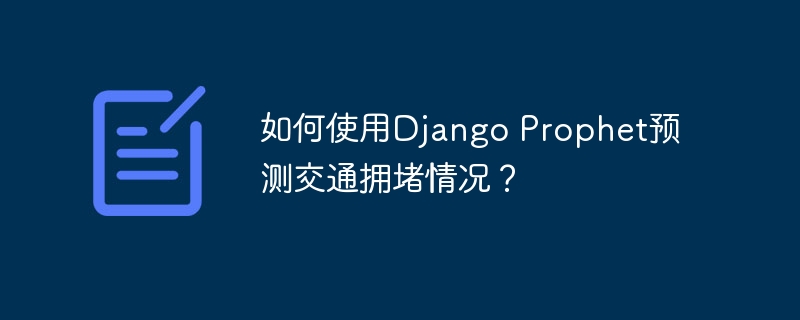Home >Backend Development >Python Tutorial >How to predict traffic congestion using Django Prophet?
How to predict traffic congestion using Django Prophet?
- WBOYWBOYWBOYWBOYWBOYWBOYWBOYWBOYWBOYWBOYWBOYWBOYWBOriginal
- 2023-09-27 20:30:40843browse

How to predict traffic congestion using Django Prophet?
Introduction
Traffic congestion is a common problem faced by every city. Solving traffic congestion requires accurate predictions of traffic flow so that appropriate measures can be taken to alleviate congestion. This article will introduce how to use the Django Prophet module to predict traffic congestion, with detailed code examples.
- Introduction to Django Prophet
Django Prophet is a Python-based time series prediction module. It is the implementation of the Facebook Prophet module under the Django framework. The Prophet module is a fast, flexible and easy-to-use time series forecasting tool developed by Facebook. It is based on an additive model and has interpretable components including trends, seasonality, holidays, etc. - Data collection and preparation
First, we need to collect data related to traffic flow. This data can come from sources such as traffic monitors and bus GPS data. In this example, we assume that we have traffic flow data over time. The data should contain a date/time column and a column representing traffic volume.
Next, we load the data and perform necessary preprocessing. We can use the Pandas library to accomplish these tasks. The sample code is as follows:
import pandas as pd
# 加载数据
data = pd.read_csv('traffic_data.csv')
# 将日期/时间列转换为日期时间对象
data['datetime'] = pd.to_datetime(data['datetime'])
# 将流量列命名为‘y’
data.rename(columns={'traffic': 'y'}, inplace=True)
# 将日期时间列设为索引
data.set_index('datetime', inplace=True)
# 对缺失值进行插值处理
data.interpolate(method='linear', inplace=True)
# 打印数据前几行
print(data.head())- Creating a Django Prophet model
Next, we need to create a Django Prophet model for time series prediction. First, we need to install the Django Prophet module. You can use the following command to install:
pip install django-prophet
Then, we need to add the following code in the settings.py file of the Django project:
INSTALLED_APPS = [
...
'django_prophet',
...
]The sample code is as follows:
from datetime import timedelta
from django.db import models
from django_prophet.models import ProphetModel
# 创建Django Prophet模型
class TrafficPredictionModel(ProphetModel):
# 定义预测时间间隔
prediction_period = models.DurationField(default=timedelta(days=7))
# 定义训练过程中的参数
@classmethod
def get_prophet_parameters(cls):
parameters = super().get_prophet_parameters()
parameters.update({
'changepoint_prior_scale': 0.05,
'seasonality_mode': 'multiplicative'
})
return parameters- Run the prediction model
After we have created the Django Prophet model, we can use the model to make predictions. First, we need to add the following code in the views.py file of the Django project:
from django.http import JsonResponse
from django_prophet.forecaster import ProphetForecaster
from .models import TrafficPredictionModel
# 运行预测模型
def predict_traffic(request):
# 加载Django Prophet模型
model = TrafficPredictionModel.load_model()
# 创建ProphetForecaster对象
forecaster = ProphetForecaster(model)
# 运行预测
predictions = forecaster.predict()
# 返回预测结果
return JsonResponse(predictions, safe=False)Then, we need to add the following code in the urls.py file of the Django project:
from django.urls import path
from .views import predict_traffic
urlpatterns = [
path('predict_traffic/', predict_traffic, name='predict_traffic'),
]Now, we can get the prediction results by sending a request to /predict_traffic/.
Conclusion
This article introduces how to use Django Prophet to predict traffic congestion. We first collected and prepared traffic flow data, then created a Django Prophet model and used the model to make predictions. By using Django Prophet, we can better understand and predict traffic congestion so that we can take appropriate measures to alleviate the congestion problem.
Hope this article will be helpful to everyone!
The above is the detailed content of How to predict traffic congestion using Django Prophet?. For more information, please follow other related articles on the PHP Chinese website!
Related articles
See more- Detailed tutorial on using cookiecutter in Django
- AI can predict your political ideology just by taking a brain scan
- The future of CV is on these 68 pictures? Google Brain takes a deep look at ImageNet: top models all fail to predict
- A review of visual methods for trajectory prediction
- How to use MySQL database for forecasting and predictive analytics?

